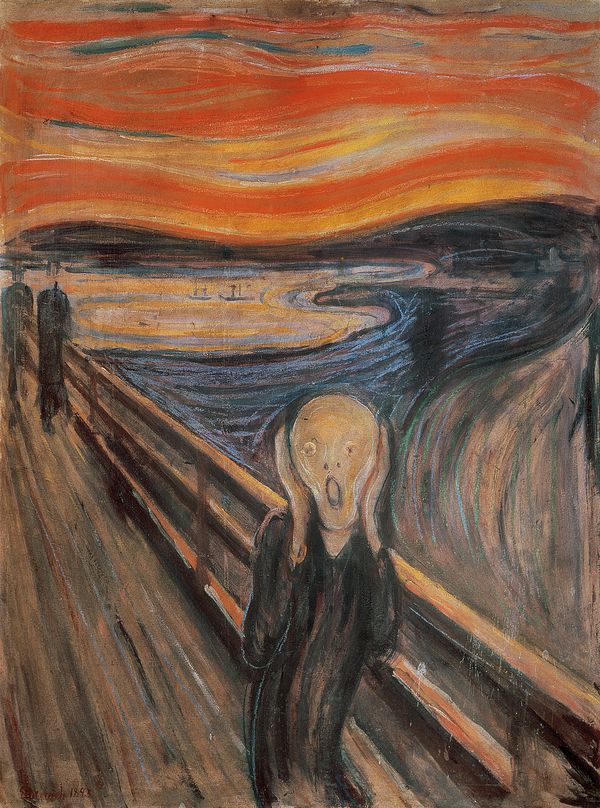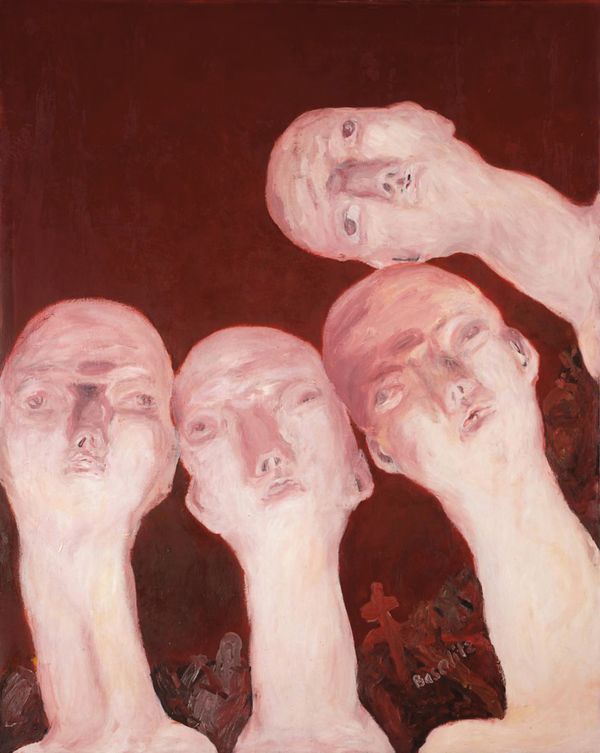Georg Baselitz P.D. Idol, 1964
You must have the will to deny content in order to begin to make a painting that will exist for itself...I begin with an idea, but as I work, the picture takes over.
—Georg Baselitz
P.D. Idol is one of five paintings that comprises Georg Baselitz' seminal Idol series from 1963-1964. Painted at a critical moment in Baselitz' career, when he first garnered international acclaim, P.D. Idol incorporates the central concerns of the artist's early painterly practice.
In P.D. Idol, 1964, Baselitz depicts an otherworldly figure set against a rich ground. Delicate visceral hues of white and sandy yellow paint modulate an elongated bust that commands the pictorial space of the canvas. Disorienting the viewer's expectations of gravity and perspective, the bald-headed figure looms larger-than-life. Its haunting eyes gaze into the distance, evoking the pathos reminiscent of religious portraiture, and the existential angst of Edvard Munch's The Scream, 1893 (National Gallery, Oslo). A visual and thematic continuation of the artist's widely lauded Oberon, 1963-1964, (Städel Museum, Frankfurt), P.D. Idol is an early example of Baselitz' career-long investigation into the human figure. Here, focusing on the depiction of the head, P.D. Idol anticipates not just Baselitz' Heroes series, but also foreshadows his later wooden sculptures.
Edvard Munch The Scream, 1893. National Gallery, Oslo, Norway
As signified by the prefix 'P.D.' in its title, this work from our 20th Century & Contemporary Art Evening Sale powerfully demonstrates the central aims of Baselitz' provocative painterly practice. Directly referencing the profoundly existential and fevered Pandemonium manifestos that Baselitz, together with fellow artist Eugen Schönebeck, published in 1961 and 1962, the present work channels the artist's intense concern with the grotesque. In these idiosyncratic texts and accompanying illustrations, the artists laid bare their desire for catharsis, which they sought to achieve by pursuing a charged combination of infantile regression, excess and deliberately vulgar provocation. Whereas his contemporaries turned to Conceptual art, Pop or Arte Povera, Baselitz returned to the human figure and embraced the 'asocial, the insane, the deviant and the amoral.' Employing a crude and heightened palette, the artist conveyed raw emotion, evoking tenets of German Expressionism and categories that had been "deemed 'degenerate' during the Third Reich" (Shulamith Behr, Georg Baselitz, exhibition catalogue, Royal Academy of Arts, London, 2007). Drawing on myriad textual and visual sources, Baselitz' artistic output between 1961-1965 was stimulated by psychiatrist Hans Prinzhorn's book Bildnerei der Geisteskranken, 1933, which featured artwork by patients with mental illnesses and Antonin Artaud's Theater of Cruelty, 1938 — a form of theatre which assaulted the audience's senses. Allowing subconscious emotions to come to the fore, Baselitz sought to mimic Artaud's shocking spectacle by exploring convulsive, bodily contortion in his painting.
Born shortly before the outbreak of World War Two, and growing up in Saxony, Baselitz possessed an artistic voice shaped by the Vergangenheitsbewältigung — the struggle to overcome the horrors of the past. In regards to this impactful legacy, Baselitz said, as quoted in Baselitz: Collected Writings and Interviews, London, 2010, "I was born into a destroyed order, a destroyed landscape, a destroyed people, a destroyed society. And I didn't want to re-establish an order: I'd seen enough of so-called order." Baselitz' own reckoning with the Vergangenheitsbewältigung led him to liberate himself from predetermined models of thought, forging a new figurative style based on collective history and personal memory in a context that was divided between the orthodoxies of Eastern Socialist Realism and Western abstraction. The artist engaged a form of expressive distortion to experiment with the challenging fronts of cultural memory and the national psyche.
['P.D. Idol'] demonstrates the central aims of Baselitz' provocative painterly practice. It channels the artist's intense concern with the grotesque...and fascination with Mannerism.
Georg Baselitz Oberon, 1963. Städel Museum, Frankfurt, Germany © Georg Baselitz 2018
Situated between the bodily fragments of Baselitz' P.D. Feet series, 1960-1963, and the full-length figures of his Heroes, 1965-1966, P.D. Idol represents the inflection point in Baselitz' evolution from 'disfiguration' to 'refiguration' in the first years of his career. While Baselitz had already explored the subject of the head with G.-Kopf, 1961, inspired by a drawing of a mentally ill patient, P.D. Idol distinguishes itself with the visceral painterly technique that he had arrived at by the mid-1960s. Another painting stemming from the series, Idol, 1963, depicts the figure in front of a stark black cross, evoking the Crucifixion of Christ — an association heightened by the title of the series.
The disparate Idol paintings are synthesized in the overarching Oberon, 1963-1964, which depicts four elongated otherworldly beings in front of what resembles a distant graveyard. Widely lauded as one of Baselitz' greatest masterpieces, Oberon's extended title, Oberon – 1. Orthodoxer Salon 64 – E. Neijsvestnij, refers to the unorthodox Soviet sculptor, Ernst Neizvestny. The Russian-American sculptor was famously criticised in 1962 by Nikita Khrushchev, when the Soviet statesman deemed his works 'degenerate', stating "Why do you disfigure the faces of Soviet people?" Reiterating Baselitz' concern with the sculptor and his controversial output, a further work from the series of five, E.N Idol, refers directly back to the Oberon, with the prefix 'E. N' also signifying Ernst Neijsvestnij's initials. With the literal translation of the Russian-American's surname 'Neijsvestnij' being 'unknown', the anonymous nature of Baselitz' ghostly protagonist is emphasized.
Jacopo Pontormo The Penitence Of St. Jerome, c. 1527. Collection of Niedersächsisches Landesmuseum, Hannover, Germany
The flattening of perspective and shocking twisted and distorted face of the figure in the present work are exemplary of Baselitz' fascination with Mannerism, which pursued exaggeration, artifice, compositional tension and instability, rather than the proportion and ideal beauty of earlier Renaissance painting. As Rainer Michael Mason has explained, in the exhibition catalogue for Georg Baselitz, Painting & Sculpture, 1960-2008, Museum der Moderne, Salzburg, 2009, "P.D. Idol (1964)…show[s] the inclination [of Mannerism], and Mannerism remains for the artist the confirmation of so many facets demonstrated again and again by his own work." P.D. Idol and its companions recall Mannerist painter Jacopo Pontormo's Saint Jerome Penitent, ca. 1525 (Niedersächsisches Landesmuseum, Hanover), which Baselitz had viewed in person. As Rainer Michael Mason observed in reference to the present work, "The saint's clean-shaven head and elongated neck, which in Pontormo's [work] swerve outside the spherical composition, seem to reappear in Baselitz' heads mounted on oversized necks that surmount the viewer in a hallucinatory perspective." Departing from the spatial manipulation of the picture plane and the lyrical function of line and silhouette, the present work sets the foundation for Baselitz' acclaimed Heroes paintings made during his stay in Florence in 1965.
I didn't want to re-establish an order: I'd seen enough of so-called order.
—Georg Baselitz
Baselitz attacked the bastion of Modernism, dissolving academic preconceptions of representation and abstraction. Commenting on his practice, reconciling past and present, the artist asserted, as quoted in 'Georg Baselitz in conversation with Jean-Louis Froment and Jean-Marc Poinsot' from 2009-2010, "The first paintings I did with…a concrete image…were not heads, in the sense of portraits, but something like an image which has a head in its centre…The way to turn an idea into reality, the simplest way, is to do a head…the head is never a portrait, it's quite simply the vehicle of my artistic ideas."
A timeless painting, the subject of P.D. Idol continues to confront us with the realities of the contemporary age.



